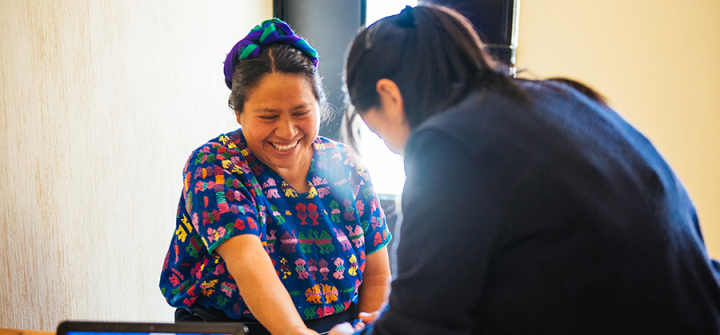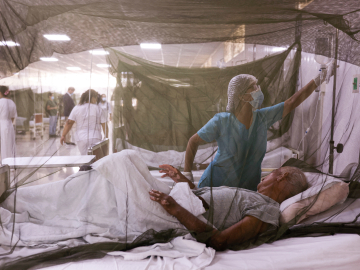The People Behind the Numbers: Diabetes Lessons from Guatemala
It’s easy to become numbed by the global diabetes epidemic.
Almost every week, it seems, new numbers are released telling us the situation is bad and only getting worse: 415 million people have diabetes around the world—80% living in low- and-middle income countries—according to the International Diabetes Federation; others respond that these official figures may severely underestimate the diabetes burden; and earlier this year a study in the premiere diabetes journal concluded that the rate of diabetes is higher in poor countries, for reasons ill understood.
But behind these numbers are real people and extraordinary suffering.
Flor, a 47-year-old woman in rural Guatemala has lived with type II diabetes for over 2 decades. Although she has several adult children, they do not help her, and her husband is no longer in the picture. With limited social support, she lives alone in a small, 2-room cinderblock home—one completely filled with her diabetes supplies. Diabetes has caused her kidneys to stop working, damaged the nerves of her legs so severely that she cannot walk the 2-mile jaunt into town, and given her intractable pain and vomiting when she eats.
I have helped care for Flor since 2013 as a physician and diabetes coordinator for Maya Health Alliance, an NGO in Guatemala. We have controlled Flor’s blood sugar with insulin injections, managed her kidney failure with home-based dialysis, treated her gastrointestinal symptoms with anti-nausea medicines, and conducted many home visits to offer social and educational support.
Yet Flor’s physical and emotional pain continues. We have been unable to undo the damage of 20 years of uncontrolled diabetes on her body, or remedy her social isolation. She once gave me permission to addend one of my clinical notes with the following exchange:
Me: Flor, I have a question I’d like to ask you. Do you want to keep going? Do you want to live?
Flor: Well…. look, Doctor…. The truth is that I don’t. I don’t want to live. I hurt, and I don’t want to suffer anymore. My legs, my back, my injections, my catheter. It all hurts. I want to go to the next world. That’s why I went to the hospital on Wednesday, when my infection started on Monday. I thought, it’s better if this is it. Look, I’m not living right now. I’m suffering. I’m ready to be in heaven. I look forward to seeing you there.
I have been extremely moved by the suffering of patients like Flor and challenged by the immense barriers to delivering high-quality diabetes care to poor patients in rural Guatemala. Strikingly, these barriers are similar to those I’ve observed in my urban clinic in Minneapolis, Minnesota—the high cost of fresh fruits and vegetables, expensive medicines and lab tests, limited family and social support, language barriers, low health literacy, unsafe neighborhoods in which to walk or exercise, a fragmented health system, and racial disparities due to discrimination and historical factors. Yet in indigenous areas of Guatemala, these elements are even more acute and severe due to the extent of rural poverty, the recent history of civil war and genocide, and a public health system that has been in crisis.
In this context, our organization recently published a study in the open-access journal PLOS One describing our experiences designing and implementing a type II diabetes treatment program in Guatemala. Although our sample of patients is very small compared to the vast diabetes burden worldwide, we show that relatively good outcomes can be attained in poor, rural parts of Guatemala with a cohort of very marginalized patients.
Although there is a vibrant literature on diabetes treatment in high-income countries, there is a need for shared programmatic and outcome data from programs in global settings. In Guatemala, we learned the hard way that delivering good diabetes care is far more difficult than simply applying clinical guidelines from the US or Europe.
Rather, it requires building systems for drug procurement and distribution, implementing education programs that are linguistically and culturally tailored, training health care workers, utilizing innovative technological tools like point-of-care laboratory testing, and managing the inevitable co-morbidities and complications—including diagnoses such as depression. It also requires figuring out how to build partnerships with allied organizations and local governments.
Our program in Guatemala expands on prior diabetes delivery work by organizations such as Partners in Health (PIH) in Rwanda, AMPATH in Kenya, MSF in Cambodia, and several nurse-led diabetes programs implemented in rural Africa. We have been especially influenced by PIH’s diabetes guide, which was published in 2011, and offers many pragmatic lessons and clinical tips. In general, there are many differences between the diabetes epidemic in Africa and Central America, especially the proportion of adult type 2 diabetes patients in the African sites that have required insulin. However, one generalizable lesson that seems to be emerging is the promising role of “task shifting,” in which non-physician providers like nurses, adequately trained and supported, are primarily responsible for delivering diabetes care and education at frontline clinics and health centers.
Of course, the global diabetes community must address the “proximal” causes of diabetes, especially strategies to decrease the consumption of cheap, highly processed, and low-quality foods.
At the same time, my experiences with patients like Flor have convinced me that there is also an imperative to develop treatment programs to try to alleviate the suffering of patients who already have diabetes and have no access to care.
David Flood MD, MSc is a staff physician with Maya Health Alliance in Guatemala and a resident physician at the University of Minnesota.
Join the thousands of subscribers who rely on Global Health NOW summaries and exclusive articles for the latest public health news. Sign up for our free weekday enewsletter, and please share the link with friends and colleagues: Subscribe to GHN
A diabetes nurse delivers diabetes care in a rural Guatemalan clinic. Image courtesy of Daniel Agee.




